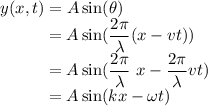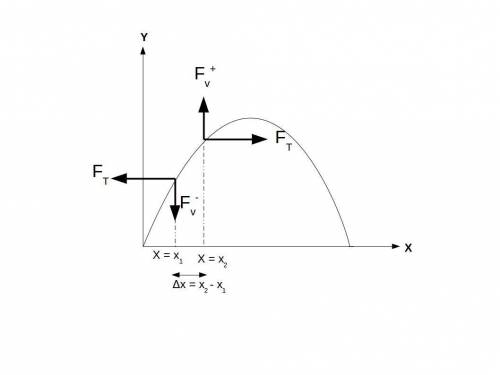
Physics, 07.03.2020 05:19 walkereddie580
A guitar string of length L = 0.94 m is oriented along the x-direction and under a tension of T = 92 N. The string is made of steel which has a density of rho = 7800 kg / m3. The radius of the string is r = 9.3 x 10-4 m. A transverse wave of amplitude A = 0.0020 m is formed on the string.
a. Calculate the mass per unit length u of the guitar string in kg/m.
b. Calculate the velocity (in m/s) of a traveling transverse wave on the guitar string.
c. Assume a form y) = A sin(a) for the transverse displacement of the string. Enter an expression for a of a transverse wave on a string traveling along the positive x-direction in terms of its wavenumber k, the position x, its angular frequency w, and the time t.
d. Assume a form y2 = A sin(a) for the transverse displacement of the string. Write an expression for a of a transverse wave on a string traveling along the negative x-direction in terms of its wavenumber k, the position x, its angular frequency w, and the time t.
e. Write an equation for a standing wave on the string y(x, t) created by y1(x, t) and y2(x, t) in terms of the amplitude of the original traveling waves A, its wavenumber k, the position x, its angular frequency w, and the time t. Use a trigonometric identity so that y(x, t) contains a sine term dependent only on k and x and a cosine term dependent only on w and t.

Answers: 3


Another question on Physics

Physics, 21.06.2019 13:50
Aboat that travels with constant speed of 6.10 m/s in still water is to go directly across a river. the current in the river flows at 1.95 m/s. (a) at what angle must the boat be steered?
Answers: 1

Physics, 22.06.2019 02:00
Chapter 23, problem 075 the figure shows a geiger counter, a device used to detect ionizing radiation (radiation that causes ionization of atoms). the counter consists of a thin, positively charged central wire surrounded by a concentric, circular, conducting cylindrical shell with an equal negative charge. thus, a strong radial electric field is set up inside the shell. the shell contains a low-pressure inert gas. a particle of radiation entering the device through the shell wall ionizes a few of the gas atoms. the resulting free electrons (e) are drawn to the positive wire. however, the electric field is so intense that, between collisions with gas atoms, the free electrons gain energy sufficient to ionize these atoms also. more free electrons are thereby created, and the process is repeated until the electrons reach the wire. the resulting "avalanche" of electrons is collected by the wire, generating a signal that is used to record the passage of the original particle of radiation. suppose the radius of the central wire is 24 âµm, the inner radius of the shell 2.3 cm, and the length of the shell 14 cm. if the electric field at the shell's inner wall is 2.8 ă— 104 n/c, what is the total positive charge on the central wire?
Answers: 1

Physics, 22.06.2019 02:30
The particle in a two-dimensional well is a useful model for the motion of electrons around the indole ring (3), the conjugated cycle found in the side chain of tryptophan. we may regard indole as a rectangle with sides of length 280 pm and 450 pm, with 10 electrons in the conjugated p system. as in case study 9.1, we assume that in the ground state of the molecule each quantized level is occupied by two electrons. (a) calculate the energy of an electron in the highest occupied level. (b) calculate the frequency of radiation that can induce a transition between the highest occupied and lowest unoccupied levels. 9.27 electrons around the porphine ring (4), the conjugated macrocycle that forms the structural basis of the heme group and the chlorophylls. we may treat the group as a circular ring of radius 440 pm, with 20 electrons in the conjugated system moving along the perimeter of the ring. as in exercise 9.26, assume that in the ground state of the molecule quantized each level is occupied by two electrons. (a) calculate the energy and angular momentum of an electron in the highest occupied level. (b) calculate the frequency of radiation that can induce a transition between the highest occupied and lowest unoccupied levels.
Answers: 1

Physics, 22.06.2019 11:30
Which accounts for an increase in the temperature of a gas that is kept a constant volume
Answers: 1
You know the right answer?
A guitar string of length L = 0.94 m is oriented along the x-direction and under a tension of T = 92...
Questions

Mathematics, 27.07.2019 23:30


Mathematics, 27.07.2019 23:30



English, 27.07.2019 23:30

History, 27.07.2019 23:30





Mathematics, 27.07.2019 23:30



Business, 27.07.2019 23:30




Social Studies, 27.07.2019 23:30

 .
.


 .
. ) is given by,
) is given by,
 ) of the string, is the sum of the tension in the string (
) of the string, is the sum of the tension in the string ( ) and the restoring force. The x-components of the force of tension will cancel each other, so the net force is equal to the sum of the y-components of the force. To obtain the y-components of the force, at
) and the restoring force. The x-components of the force of tension will cancel each other, so the net force is equal to the sum of the y-components of the force. To obtain the y-components of the force, at 



 ) on the string element is given by
) on the string element is given by![F_{net} = F_{V}^{+} + F_{V}^{-}\\~~~~~~~= F_{T}[ (\dfrac{\partial y}{\partial x})_{x = x_{2}} - (\dfrac{\partial y}{\partial x})_{x = x_{1}}]](/tpl/images/0537/9158/437ae.png)
 , where
, where ![&& \Delta x \times \mu \dfrac{\partial^{2}y}{\partial t^{2}} = [(\dfrac{\partial y}{\partial x})_{x = x_{2}} - (\dfrac{\partial y}{\partial x})_{x = x_{1}}] \times F_{T}\\&or,& \dfrac{\mu}{F_{T}} \dfrac{\partial^{2}y}{\partial t^{2}} = \dfrac{[(\dfrac{\partial y}{\partial x})_{x = x_{2}} - (\dfrac{\partial y}{\partial x})_{x = x_{1}}]}{\Delta x} = \dfrac{\partial^{2}y}{\partial x^{2}}](/tpl/images/0537/9158/8b5fb.png)

 ) of the transverse wave is
) of the transverse wave is
 ' propagates along positive x-direction with the constant velocity '
' propagates along positive x-direction with the constant velocity ' ' , then its angular displacement '
' , then its angular displacement ' ' is related to the linear displacement 'x' is written as
' is related to the linear displacement 'x' is written as
 .
.
 ' is the wave number
' is the wave number  and
and  is the natural angular frequency.
is the natural angular frequency.



 and
and  is the superposition of the waves and is given by
is the superposition of the waves and is given by



